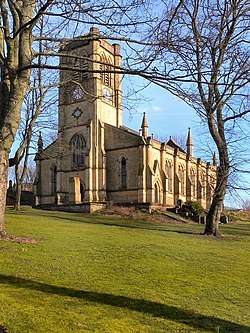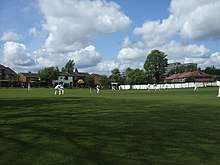Blackley
Blackley /ˈbleɪkli/ (![]()
| Blackley | |
|---|---|
 The Grade II* listed Church of St. Peter | |
 Blackley Location within Greater Manchester | |
| Population | 10,196 (2001 Census) |
| OS grid reference | SD853028 |
| • London | 186 m |
| Metropolitan borough | |
| Metropolitan county | |
| Region | |
| Country | England |
| Sovereign state | United Kingdom |
| Post town | MANCHESTER |
| Postcode district | M9 |
| Dialling code | 0161 |
| Police | Greater Manchester |
| Fire | Greater Manchester |
| Ambulance | North West |
| UK Parliament | |
History
The hamlet of Blackley was mentioned in the Domesday Book. The name derives from the Anglo-Saxon Blæclēah = "dark wood" or "dark clearing". In the 13th and 14th centuries Blackley was referred to as Blakeley or Blakelegh'.[1] By the Middle Ages, Blackley had become a park belonging to the lords of Manchester.
Its value in 1282 was recorded as £6 13s 4d, a sum approximately equivalent in buying power to £333,500 today.[1][2] The lords of Manchester leased the land from time to time. In 1473, John Byron held the leases on Blackley village, Blackley field and Pillingworth fields at an annual rent of £33 6s 8d.
The Byron family continued to hold the land until the beginning of the 17th century when Blackley was sold in parcels to a number of landowners.[1] By the middle of the 17th century, Blackley was a rural village of just 107 inhabitants. This lasted until the start of gradual residential development in the 1930s to 1960s, where most farmland was built upon.
Today, only pockets of the suburb are undeveloped green space, with farmland remaining close to the Manchester Ring Motorway.

Governance
Blackley is a part of the parliamentary constituency of Blackley and Broughton, The current Member of Parliament is Graham Stringer (Labour). The Main Opposition has been the Conservative Party , whose candidate came second in the general election of 2019, with 24.6 of the vote, a 3% increase from 2017.
The suburb is split between the local government wards of Higher Blackley and Charlestown on Manchester City Council. The three councillors for both wards are members of the Labour Party.
Economy
During the 1930s, residential development started to take place in the formerly rural village to provide more homes for Manchester's now growing population. This is now an area with a mixture of housing, which is mainly privately owned homes; owner occupied and privately rented. In 2014, Blackley appeared on a list of Top 10 Places to Live In Greater Manchester.
The suburb is popular for commuters into Manchester City Centre, and little numbers work directly in the suburb itself, with exceptions of the Hexagon Tower Development, which close to North Manchester Hospital, which is a centre for scientific research into plastics and related innovation.
The church of Saint Peter
The Church of St Peter on Old Market Street is a Gothic Revival church, which was built in 1844 by E. H. Shellard. It was erected at a cost of £3162. It was designated a Grade II* listed building on 20 June 1988. The interior is aisled and particularly impressive for its complete 170 year old interior, with the extremely unusual survival of all the fine boxes and pews.
The churchyard contains the war graves of ten service personnel of World War I, and seven of World War II.
Green spaces
Blackley is extremely well served in terms of green space:
Boggart Hole Clough
Boggart Hole Clough is a large woodland and urban country park where many walks can be undertaken, guided or otherwise. Thanks to recent funding the park now has many leisure facilities; a bowling green, tennis and basketball courts, a boating lake and a children's play area. It has its own permanent orienteering course and an athletics track. Visitors can enjoy family fun days in the summer and an annual firework display. There is a considerably old stone bridge across the brook running through the clough.
The clough was designated a local nature reserve in 2008.
Blackley Forest
A Site of Biological Importance and an example of one of the country's first Community Woodlands. Planted to commemorate the Queen's coronation and also the local people who gave their lives in the Second World War. The area has had woodland on it since the Norman Conquest in 1066, when wild boar and deer roamed and eagles flew above.[3]
The forest is a diverse mix of woodland, grassland and wetlands, dissected by a well established network of paths and steps. The River Irk can be seen in its most natural state, fringed by birch trees with some colonies of autumn crocus.
Heaton Park
Heaton Park, at around 650 acres (2.63 km2), is the biggest park in Greater Manchester, and one of the largest municipal parks in Western Europe, providing some 25% of Manchester's total green space. It is the grounds of Heaton Hall, a Grade I listed, neoclassical 18th century country mansion. The hall was remodelled to a design by James Wyatt in 1772,[4] and is now open to the public as a museum and events venue.
Although the park is officially part of the City of Manchester, two of a number of entrances are accessed from the suburb of Blackley, on Middleton Road.[5]
Transport
Blackley is well served by buses primarily along the main arterial routes of Rochdale Road (A664), and Cheetham Hill Road/Bury Old Road (A665) directly to and from Manchester city centre. Initially these would have been provided by the precursors to, and Manchester Carriage and Tramways Company, and currently by First Greater Manchester.
Other journeys are provided by Stagecoach Manchester, which took over JPT in April 2014. There are frequent Metrolink trams from Bowker Vale to and from Manchester city centre and as far south as Altrincham and as far north as Bury. Manchester's M60 orbital motorway is the northern boundary of Blackley.
Education
Primary Schools
Blackley has a number of primary schools, which include:
- Charlestown Community Primary School
- Crab Lane Primary School
- Crosslee Community Primary School
- Holy Trinity CE Primary School
- Mount Carmel RC Primary School
- Pike Fold Primary School
- St Clare's RC Primary School
- St John Bosco RC Primary School
- Victoria Avenue Primary School
Secondary Schools
- The Co-operative Academy of Manchester
- Manchester Creative and Media Academy
- Our Lady's RC High School.
Special and Alternative Schools
- Camberwell Park School
- Manchester Hospital Schools
- North Ridge High School
Sports
Blackley Golf Club

The award winning Blackley Golf Club has occupied its present site close to the M60 since 1937. The club celebrated its centenary in 2007, and a new clubhouse opened in 2009. The Clubhouse offers use for wedding receptions and private hire. There is a Golf shop open to Club Members and the public. Furthermore there is a public footpath that runs the length of the course’s green and Perimeter, Separated by fields from the M60 Motorway.The course is sponsored by Williams BMW, a local dealership
Blackley Cricket Club

Blackley Cricket Club currently play in the Greater Manchester Cricket League. The club is located on Crab Lane. In 2009, they won the cricket league title for Greater Manchester.
Notable people
(either born in Blackley, or resident of Blackley)
- John Monks, Baron Monks of Blackley: Member of the House of Lords. Former General Secretary, TUC
- Hasney Aljofree, Swindon Town footballer
- John Bradford, Protestant martyr
- Northside singer, Warren “Dermo” Dermody
- Stephen Bywater, professional footballer
- Howard Davies, Economist and Author: Current Chairman of the Royal Bank of Scotland and former director of the London School of Economics.
- David Heyes, Labour Politician: Former Labour MP for Ashton-under-Lyne
- Bernard Hill, actor of film, stage and television
- Jon Macken, former Manchester United and Manchester City footballer
- Bernard Manning, comedian
- Wilf McGuinness, former Manchester United player and manager
- Joe McIntyre, Former Professional Footballer
- Malcolm Roberts, Musician, Entertainer and Eurovision contestant.
- Roger Byrne, captain of Manchester United and one of eight players who died in the Munich air disaster of February 1958.
- Peter Townley, Church of England Archdeacon – current Archdeacon of Pontefract
- Vini Reilly, Musician: The Durutti Column
See also
References
- "Townships: Blackley" (HTTP). A History of the County of Lancaster: Volume 4 (1911), pp. 255–59. British History Online. Retrieved 10 April 2007.
- "Currency converter" (HTTP). The National Archives. Retrieved 10 April 2007.
- "History of Blackley Forest". Friends of Blackley Forest. Archived from the original (HTTP) on 8 July 2011. Retrieved 14 July 2010.
- "Heaton Hall & Orangery". Manchester City Council. Archived from the original (HTTP) on 2 May 2010. Retrieved 14 July 2010.
- "History & Architecture". Manchester City Council. Archived from the original (HTTP) on 13 September 2010. Retrieved 14 July 2010.